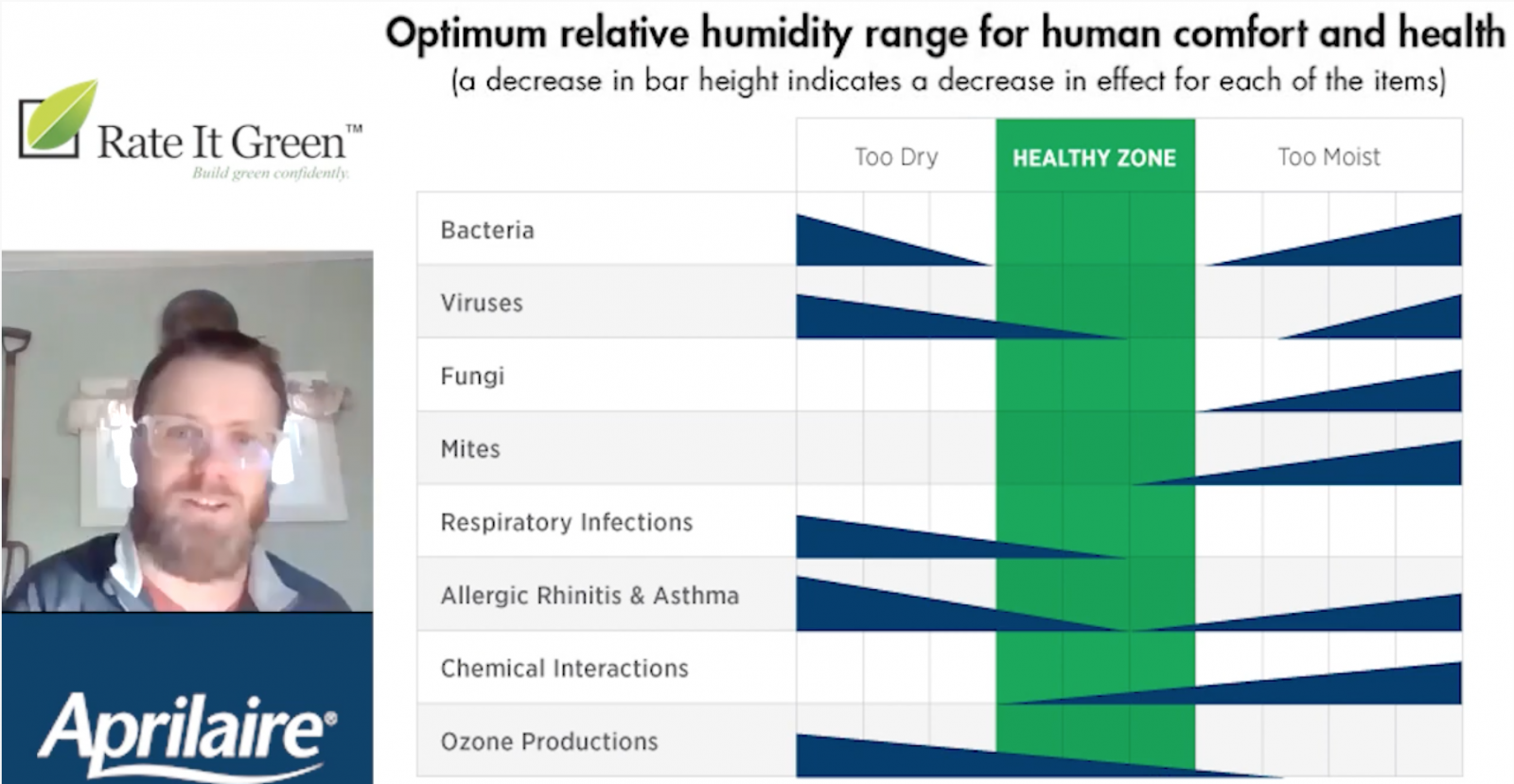Green Building Community
Whole House Humidity Control - Dehumidification and Humidification, with Aprilaire
Posted by: Rate It Green Team
Two building industry experts get on a Zoom, one in Wisconsin and one in Georgia… There’s a lot to discuss about humidity!
In all seriousness, Aprilaire’s Joseph Hillenmeyer joins Matt Hoots for a helpful discussion about humidity in our air, and how humidity relates to comfort, health, and energy efficiency.
Relative humidity is used to describe the amount of water vapor that is in the air, generally expressed as a percent. Most people have some awareness of humidity, but we might not fully understand why it’s important. Like temperature, humidity has an optimal range for human comfort and health, and also for the preservation of the home or building. Whether too low or too high, Joseph explains why we have issues on both ends of the scale. The American Society of Heating, Refrigerating and Air-Conditioning Engineers, commonly known as ASHRAE, recommends a humidity range between 30 and 60%, but if possible, it’s really a narrowed 40-50% range where humans are most comfortable and have the most benefits for health maintenance.

As the above chart shows, bacteria and viruses benefit from the extremes, both too dry and too moist. Fungi and mites prefer more moisture.
People with respiratory infections often benefit from efforts to increase humidity when an environment is too dry, but those suffering from allergies suffer in both excessively dry and excessively humid environments. In the 40-60%, 40-55% humidity range, our immune systems are a little better able to fight off health challenges. Our immune systems need the moisture to function their best.
Our building environments are also sensitive to humidity. Wood provides an example of a material which unfortunately frequently suffers from humidity extremes. As Joseph explains, “Wood, like people, doesn’t appreciate being overly saturated or too dry, and if you do both of those in one year, you can particularly cause damage.” Building industry professionals have likely unfortunately seen that with wood flooring or trim from time to time, among other products. It’s true that we all know about doors that stick in the summer and don’t stick in the winter…
The good news, according to Joseph, is that it really is possible to stay within that band with solutions available to us now.
When it’s too dry, such as in the North and particularly during the heating season, if we’re not adding the right moisture levels to the air, our heating systems lower the amount of moisture the air can hold. This lower humidity makes us feel dry and can cause bloody noses, as well as itchy skin and eyes. Oddly enough, it also cases static shock (Would you imagine that static shock is one of the most searched terms for people looking for humidifiers?)
An evaporative humidifier adds humidity through the use of a wick, and then increases the relative humidity percentage by sending the air through the forced air system. This is a fairly simplistic but effective whole house system. And it sure beats trying to use multiple portable units. Maintenance generally consists of changing the water panel from time to time, approximately once per season, where a portable unit likely needs a new panel daily. This said, Joseph recommends doing something over nothing - portables can help in smaller apartment or where a whole-house option is not possible.
A steam humidifier pushes steam into ductwork by heating water within a canister through the use of electrodes. The steam is then dispersed carefully so it’s absorbed. These units are higher capacity, and are effective in very cold climates and in larger buildings, of 3500 square feet, or more. They can also be effective in arid climates where it’s dry most of the time. Interestingly, demand isn’t yet as high in the West and Southwestern arid climates. One theory is that people have become used to the drier air, or think they have.
People often believe that air conditioning systems will “take care of” dehumidification, but this isn’t entirely sensible. As Joseph explains, a dehumidifier’s sole purpose is to remove the moisture from the air, where the purpose of air conditioning is to change the temperature of the air. These processes work similarly, but they have different goals, and it’s best to use the right tool for the job. It also takes different levels of energy and different amounts of time to do each job properly.
If there are high levels of humidity in the air, especially air coming into the house, you’re going to want to treat that with something that was made to lower the relative humidity. Doing this in conjunction with air conditioning equipment will allow the system to maintain energy efficiency - while also creating a healthier, more comfortable environment. For example, simply lowering the temperature drastically won’t magically, properly dehumidify the air the optimal amount.
It’s a combination of temperature and humidity working together that create this zone where people are most comfortable, and it’s more complicated than most people would think. One reason is that it’s more difficult to add and remove humidity from the air than it is to change the temperature of the air. It’s worth thinking through for humid climates the following comparison:
72 degrees and 45% humidity is actually more comfortable
than
62 degrees and 55% humidity, where one will feel both cold and clammy
This example shows that comfort is not based on temperature alone, and that humidity plays a significant role. We might perceive comfort the same for both of those conditions listed above in theory, but this won’t match the reality (ask Matt, in Georgia, where it gets pretty humid). So a person in the first situation might attempt to lower the temperature to lower the humidity, but the temperature will drop quickly and the humidity won’t be able to keep up. Energy wise, the higher temperature and lower humidity also cost much less to maintain. If we attempt to use a system without dehumidification equipment to lower humidity, the temperature decreases to the set point, but the humidity change is likely insufficient, and the occupant isn’t even more comfortable.
Some thermostats can integrate to control temp and humidity. Key is to embrace the technology and to be smart about the design of the home, to use the right tool for the job. It’s important that builders not just oversize systems. In these cases, the system will get to the temperature quickly, but there won’t be enough time to properly cycle out the humidity in the air. Instead, systems should be sized for the conditions and then humidity controls should be added for maximum comfort. Matt Hoots points out that so much of this discussion is about comfort, and not energy efficiency. “If we really cared about energy efficiency, we would take cold showers and turn the HVAC system off. But then we’d be uncomfortable, and we’d be miserable. It's’s about human comfort and how can we create this human comfort in an efficient manner."
It’s key to note that ideal humidity range is a goal and not always possible. One barrier to even a properly sized system might be a leaky house. For example, if a house in the Northeast is really leaky, it might be difficult to get even to ASHRAE’s 30% suggested humidity goal. In the right conditions, with today’s equipment Joseph and Matt agree that 40% humidity is possible. In a leaky house or if it’s super cold outside, occupants might have to be happy at a much lower number. According to Joseph, the goal is to take a moving target and move it up to the best of our reasonable ability.
The COVID-19 pandemic brought humidity and other aspects of indoor air quality into the forefront of public health and healthy building discussions. Originally, there was hope that summer would reduce the virus drastically. Some of this expected effect is because people are outside more in warmer weather, but indoors it’s the case that viruses are less effective in higher humidity environments. Thesis because they can stay in the air longer in drier air, where they attach to moisture and tend to fall to the ground more quickly in humid environments.
In creating ideal indoor air quality conditions, humidity plays a key role, along with ventilation, filtration and purification. As Joseph says, “It takes a little bit of everything to conquer these problems. That’s where all these systems come together, and they have to working conjunction in a while house approach.”

Please be kind and respectful!
Please make sure to be respectful of the organizations and companies, and other Rate It Green members that make up our community. We welcome praise and advice and even criticism but all posted content and ratings should be constructive in nature. For guidance on what constitutes suitable content on the Rate It Green site, please refer to the User Agreement and Site Rules.
The opinions, comments, ratings and all content posted by member on the Rate It Green website are the comments and opinions of the individual members who posts them only and do not necessarily reflect the views or policies or policies of Rate It Green. Rate It Green Team Members will monitor posted content for unsuitable content, but we also ask for the participation of community members in helping to keep the site a comfortable and open public forum of ideas. Please email all questions and concerns to admin@rateitgreen.com

